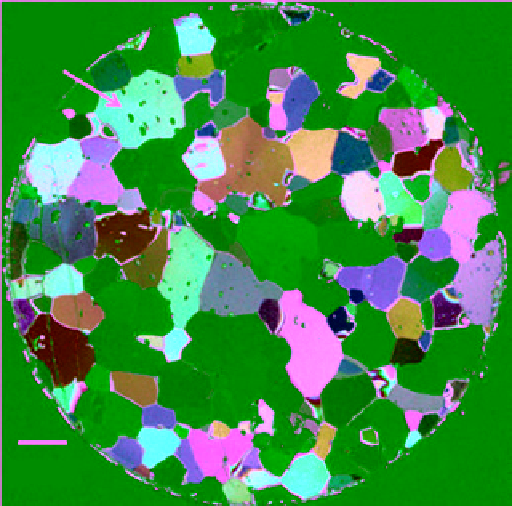Geology Reference
In-Depth Information
Air
bubbles
C
S4 type
S5 type
Figure 4.9
Three‐dimensional schematic diagrams of (a) ran-
domly oriented congealed S4‐type frazil ice and (b) vertically
oriented S5‐type frazil ice with the long axis of the crystals in
the vertical plane; arrows indicate the orientation of the
c
axis.
ratios of the discoid vary greatly, in the range of 1:5 to
1:20 or more [
Hobbs,
1974]. Grains in frazil ice reflect the
characteristics of the needles and hence the fragmented
discoids. In turbulent waters, the geometric orientations
of the needles could be random. If consolidation and
eventual solidification occur, the frozen body maintains
the randomly oriented crystal structure of the slush.
This type of congealed frazil slush has been classified as
S4 type by
Michel and Ramseier
[1971] (Table 4.1).
If the mass of frazil crystals carried away by the water
current is blocked by any existing structure or an ice body,
the needle‐shaped particles accumulate on the upstream
side and tend to be packed with their long axis normal to
the surface of the ice cover. Upon freezing, vertically ori-
ented frazil ice is formed with isotropy in a plane normal
to the current and the long axis of the grains tend to be
parallel to the vertical direction. This causes the
c
axis of
the grains to be oriented in a plane normal to the current
or in the horizontal plane [
Sinha,
1986]. Tidal activities
may lead to the formation of oriented frazil ice in long
fjords. Ocean current may also carry frazil to accumulate
at the underside of ice sheets. This particular type of fra-
zil ice may be categorized as S5 as shown in Table 4.1.
Schematic diagrams of randomly oriented S4‐type frazil
ice and vertically oriented congealed S5 type frazil ice are
shown in Figure 4.9. Since the
c
axis in the needle‐shaped
frazil crystals is normal to the long axis of the crystals,
the overall orientation of
c
axis is random in randomly
oriented S4 type of frazil ice. Because the crystals with
their long axis tend to be vertically oriented in S5 type of
frazil ice, the average orientation of the
c
axis is in the
horizontal plane or parallel to the surface of the ice.
Vertically oriented FY frazil sea ice (now classed as S5
type) was found to cover the shore‐fast ice attached to the
eastern shoreline in Mould Bay, Prince Patrick Island,
Canada, during the early winter of 1981. Mould bay is a
25 km long sound and oriented north to south with its end
in the north (see section 5.1.1). The tide comes from the
10 mm
Figure 4.8
Nearly isotropic granular large‐grained sintered snow
ice, with elongated air bubbles trapped inside the grains, from Ward
Hunt Ice Shelf, Ellesmere Island, Canada (photo by N. K. Sinha,
unpublished). (For color detail, please see color plate section).
ice in freshwater ice, practically isotropic shelf ice (at
Ward Hunt Ice Shelf) could exhibit significantly large
grains, as shown in Figure 4.8. Consequently, ice islands
calved from ice shelves and floating in sea mixed with
new and old sea ice can have layers of large grains and
nearly equiaxed (with small anisotropy) characteristics
[
Barrette and Sinha,
1994
/
96]. Detailed analysis of the ice
in Ward Hunt Ice Shelf, the main component of an ice
island floating in the Arctic Ocean during the 1980's, is
presented in Section 5.2.2.
4.3.3.2. Randomly Oriented (S4) and Vertically Oriented
(S5) Frazil Ice
Frazil ice consists of disc‐ or needle‐shaped crystals
suspended in the water. Unless anchored the crystals
usually form a thin, oily, or translucent‐looking film that
tends to float to the water's surface or suspend near the
bottom surface of existing ice cover. When atmospheric
temperature drops, the crystals clump together to form a
dense slush saturated with water. Frazil ice develops from
the consolidation and freezing of this water‐saturated
slush containing needles of ice. Initially, frazil crystals form
in a rapidly flowing or turbulent body of supercooled
water. Frazil crystals result from the fragmentation of
small and thin disc‐like crystals. The discs develop as a
result of the lateral growth of the nucleated crystals in the
basal plane (discoid grow at a higher rate in the lateral
direction or the basal plane). The thickness‐to‐width






























